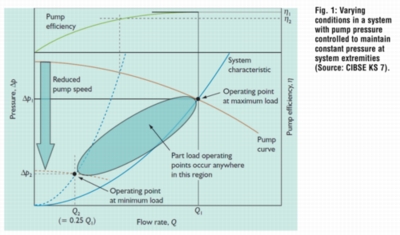Reducing pumping costs by 76%

Stephen Hart explains the importance of system design to get the maximum energy-saving and operational benefits from variable-speed pumps.
Until recently most large heated or chilled-water air-conditioning systems in the UK were designed for constant flow and utilised 3- or 4- port automatic temperature valves to divert the required amount of water flow through in-room heat exchangers such as fan coils. The local heating or cooling load is influenced by a number of factors including outside air temperature.
Whilst providing an effective method of indoor climate control, pumping heated or chilled water around a building, only to bypass the heat exchanger at the last moment, is extremely wasteful in energy. As the full heating or cooling load on a building occurs for 5% or less of the year, it is extremely important to match the power absorbed into a heating or cooling system to the actual load placed upon it.
Manufacturers of pumps, fans and other equipment have successfully utilised variable-speed drives that can slow motors to reduce power consumption at periods of low demand. By combining variable-speed pumps and 2-port temperature-control valves that close rather than divert through a bypass port, together with pressure sensors and pump controllers, a water-based air-conditioning system can operate under variable-flow conditions in response to varying heating and cooling loads.
Due to the pump affinity laws, if the flow is reduced to 25% of full flow, the pump speed is reduced to 25% of its maximum. However, the pump head is reduced to 6.25% and the pump power output is reduced to only 1.6% (i.e. 25% of 6.25%) of its maximum. Actual pump power consumption (electrical) is likely to be a little higher than 1.6% because of a reduction in pump efficiency (Fig. 1), but this effect will be marginal.
Unfortunately there are unwanted pressure fluctuations in the pipework as pumps change speed and 2-port valves open and close in a variable-flow system. These changes result in underflows and overflows and corresponding undercooling and heating or overcooling and heating at part load. However, this unwanted side effect can be managed by careful use of differential-pressure control valves or the installation of pressure-independent control valves at each of the in-room heat exchangers.
A recent study by Frese and Grundfos in Denmark demonstrated that when a variable-speed pump, end-point pump sensor and pressure-independent control valves were installed on a typical variable-flow, pump energy consumption was reduced by 76% compared to the same system with a constant speed pump and manual balancing valves. Overflows and underflows were eradicated, and supply and return water temperatures were guaranteed as the system remained dynamically balanced at all load conditions.
The dramatic saving in pump electrical energy consumption is only half of the story, due to beneficial effect of maximising the difference between system supply and return temperatures (DT).
The energy consumption of a chilled-water cooling system comprises of three main parts.

• Energy to chill water.
• Energy to pump water around the system.
• Energy loss from the return pipework.
It is also very important to minimise energy consumption in heating systems by achieving a low return temperature so condensing boilers condense at all load conditions.
The cost of operating the chiller can typically account for as much as 40% of energy use in cooling systems, but their efficient operation is often impaired by elevated return temperatures caused by overflows in variable-flow systems or blending of supply and return water in primary headers or through chillers that have been staged off.
Further, on large distribution systems, the heat losses from lengthy return pipework can be minimised if the return temperature is maintained as close to atmospheric temperature as possible. Pressure-independent control valves maintain system design DT at all load conditions and eradicate losses through inefficient chillers working when they are not required and by minimising the temperature gradient to atmosphere in the return pipework to the plantroom.
Stephen Hart is sales director with Frese.









